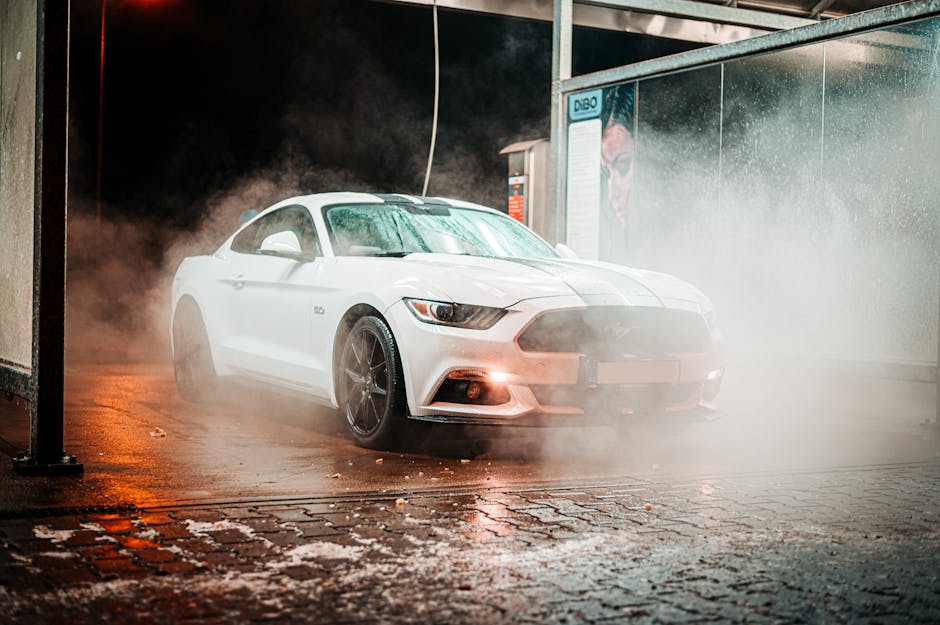Introduction to Waterless Car Wash and Traditional Car Washing Methods
When it comes to keeping your car shiny and clean, you’ve got two main options: the waterless car wash and traditional car washing methods. So, what’s the deal with these two? Let’s break it down. Traditional car washing is probably what you grew up with. It involves soap, water, a bucket, and a lot of elbow grease. You either do it in your driveway or head to a car wash. It’s all about scrubbing away the dirt and grime with gallons of water. On the flip side, the waterless car wash is a newer method. It uses special sprays that lift the dirt off your car’s surface. You then wipe it off with a microfiber cloth, no hose or bucket of water needed. This method is great for folks looking to save water and for those living in places with water use restrictions. Both methods have their fans and their place in the world of car care. Let’s dive deeper into what makes each tick and which might be the better choice for your ride.
Understanding the Waterless Car Wash Process
A waterless car wash uses special sprays and solutions to clean your car without a drop of water. Here’s how it goes: You spray the solution onto your car, and it breaks down the dirt and grime. Then, with a microfiber cloth, you wipe away the mess. It’s not just about keeping your car shiny; it also protects your car’s paint by lifting the dirt off so it won’t scratch the surface when wiping. This method saves a ton of water, making it eco-friendly and perfect for areas with water restrictions. Plus, it’s a time saver. You can do it anywhere without needing a hose or bucket. The simplicity makes it appealing, but remember, it might not be the best choice for cars covered in mud or heavy dirt. For everyday dirt, though, it’s a winner.
Traditional Car Washing Techniques Explained
Traditional car wash methods often involve a bucket of soapy water, a hose, and a sponge or cloth. Here’s how it usually goes down: you soak the car, scrub away the dirt and grime with the soapy water, and then rinse it off with a hose. After, you might dry it with a clean, soft towel to prevent water spots. This method uses a lot of water—typically between 20 to 50 gallons per wash. It’s straightforward but not very eco-friendly. The soap and dirty water can also harm the environment as they flow into storm drains, leading to pollution in local waterways. Despite its downsides, this method has been the go-to for years, mainly because it’s accessible and, to an extent, effective at keeping cars looking clean.
Environmental Impact: Waterless Car Wash vs. Traditional Methods
Choosing between a waterless car wash and traditional methods isn’t just about your car’s shine—it’s also a big deal for our planet. Traditional car washing methods can use up to 100 gallons of water per wash. That’s a lot of H2O, especially in areas where water scarcity hits hard. Plus, the runoff from these washes often carries soaps and chemicals into our rivers and oceans, harming aquatic life.
On the flip side, waterless car wash products pretty much do what the name suggests—they clean your car without needing a single drop of water. These products usually come in a spray bottle and contain lubricants and cleaning agents that lift dirt right off the car’s surface. This means virtually no water waste and significantly reduced chemical runoff into the environment.
Here’s the takeaway: If you’re looking to reduce your environmental footprint, going with a waterless car wash is a no-brainer. It saves gallons of water, reduces chemical runoff, and still leaves your car sparkling. Plus, it’s a convenient option you can do anywhere, anytime.
Cost Comparison: Saving Money with Waterless Car Wash?
When it comes to washing your car, you might not think there’s much of a price difference between waterless car wash products and traditional methods. However, over time, choosing a waterless car wash can actually save you money. Let’s break it down. Traditional car washes, especially if you go to a professional, can cost anywhere from (10 to )30 per visit, depending on the services you choose. If you wash your car at home, you still need to buy soap, wax, and other products, not to mention the water bill spike. A waterless car wash product might seem pricier at first glance, with costs ranging from (15 to )50 per bottle, but here’s the catch – one bottle can last for multiple washes, sometimes up to 10 or 20, depending on the size and how liberally you use it. So, when you do the math, the cost per wash drops significantly, making it a more economical choice over time. Plus, you’re not just saving money; you’re also saving water and reducing your environmental footprint. In summary, if you’re looking to pinch pennies and be a bit kinder to the planet, giving waterless car wash a shot might be a smart move.
The Effectiveness of Waterless Car Wash on Different Types of Dirt and Grime
For those of you turning your gaze towards the waterless car wash, you might wonder how it stands up against the usual bucket and hose method, especially when tackling various kinds of muck that decorate your car. First off, let’s get straight to the point: waterless car wash products are surprisingly effective. They’re not just for lightly dusted surfaces but also for handling moderate dirt and grime. The secret lies in the special formulas these products use. Loaded with lubricants, they lift dirt from the car’s surface, making it easy to wipe away without scratching the paint.
However, if you’re up against tougher stuff like mud caked on from that adventurous off-road weekend or winter’s assault of salt and sand, waterless methods might fall short. In these cases, traditional water washes have the upper hand. They provide the needed force to break down and wash away stubborn grime.
In essence, for everyday dirt and urban grime, go waterless and enjoy a clean, shiny car without much fuss. But for the heavy-duty messes, you might still need to roll up your sleeves and bring out the hose. It’s all about using the right tool for the job.
Traditional Car Wash Methods: Pros and Cons
Traditional car wash methods, think soap, water, and a good scrub, have their ups and downs. Pros include a thorough cleaning. Your car doesn’t just look spotless; it feels it too. Water and soap dissolve and wash away dirt, grime, and salt that can corrode your car’s body. Plus, the hands-on approach often means tough stains and spots get the extra elbow grease they need. Another big plus is the accessibility and affordability. You can do it in your driveway with supplies you probably already have, or find a car wash service nearby without breaking the bank.
Cons, however, make you think twice. Firstly, it uses a lot of water. Depending on how you do it, washing your car like this can use up to 150 gallons of water per wash! That’s a lot, especially if you’re conscious about water conservation. Then there’s the potential for damage. Incorrect techniques or harsh materials can scratch your car’s paint, leaving it looking worse than before. Also, it’s time-consuming. Doing it yourself means giving up a chunk of your day, and going to a service requires waiting your turn, which isn’t always quick. Lastly, it’s not always the most eco-friendly option since that dirty water, mixed with chemicals from your cleaner, often ends up back in the environment.
Waterless Car Wash: Benefits and Limitations
Waterless car wash sounds like a game-changer, right? It’s pretty much what it says – cleaning your car without the hose and buckets of water traditional methods rely on. This approach uses special sprays to wipe away dirt, grime, and stains from your car’s surface. Now, let’s talk pros and cons. The benefits are hard to ignore. For starters, it saves a ton of water. Think about it, a regular car wash can use up to 100 gallons per wash, but with waterless, you’re barely making a dent in your water usage. It’s also super convenient. You can do it anywhere – your garage, the street, or a parking lot – without needing access to water. Plus, it’s quick; you spray, wipe, and you’re done. And, for those worried about scratches, the specialized formulas are designed to lift dirt away safely, reducing the risk of damage to your car’s paint job.
But, it’s not all smooth sailing. The limitations are there. If your car is caked in mud or heavy dirt, waterless might not cut it. These products are perfect for light to moderate dirt but struggle with the heavy stuff. Also, while the risk to your paint is minimized, it’s not entirely eliminated. Incorrect use or very gritty dirt can still lead to scratches. Lastly, the cost. These sprays aren’t always cheap, especially if you’re cleaning your car frequently.
So, waterless car wash offers a convenient, eco-friendly option, but it might not replace traditional methods for everyone. It’s about finding what works best for your situation and your car.
Making the Right Choice for Your Vehicle’s Needs
Choosing between a waterless car wash and traditional methods boils down to what your car needs and where your values lie. If you live in a city with water restrictions or you’re keen on saving water, a waterless car wash is your go-to. This type uses special sprays to clean the car without a single drop of water. It’s quick, efficient, and you can do it almost anywhere. On the other hand, if you have heavy mud or dirt to tackle, a traditional car wash has the power to give your car a deeper clean. It might use more resources, but for a thorough wash, it’s unparalleled. However, remember, traditional washes require setting aside time to either do it yourself or visit a car wash, whereas waterless options give you the flexibility to clean your car on your schedule. Make your choice based on what matters most to you—convenience, environmental consciousness, or the level of cleanliness required.
Conclusion: Balancing Convenience, Cost, and Environmental Impact
Choosing between a waterless car wash and traditional methods boils down to what you value most. If saving time and reducing your environmental footprint are top priorities, waterless options shine. They’re quick, use less resources, and you can do them anywhere. Yes, they might be a bit pricier upfront, but the convenience and eco-friendliness could be worth it. On the flip side, traditional washes have their place. They can be more thorough, which is great for a deep clean. They’re often less expensive initially, but remember, they use heaps of water and typically require you to go out of your way to visit a car wash. In the end, your choice should reflect a balance of convenience, cost, and concern for the environment. No method is perfect, but being informed helps you make the best decision for you and your car.


